economy
We use cookies to help you navigate efficiently and perform certain functions. You will find detailed information about all cookies under each consent category below.
The cookies that are categorized as "Necessary" are stored on your browser as they are essential for enabling the basic functionalities of the site. ...
Necessary cookies are required to enable the basic features of this site, such as providing secure log-in or adjusting your consent preferences. These cookies do not store any personally identifiable data.
Functional cookies help perform certain functionalities like sharing the content of the website on social media platforms, collecting feedback, and other third-party features.
Analytical cookies are used to understand how visitors interact with the website. These cookies help provide information on metrics such as the number of visitors, bounce rate, traffic source, etc.
Performance cookies are used to understand and analyze the key performance indexes of the website which helps in delivering a better user experience for the visitors.
Advertisement cookies are used to provide visitors with customized advertisements based on the pages you visited previously and to analyze the effectiveness of the ad campaigns.
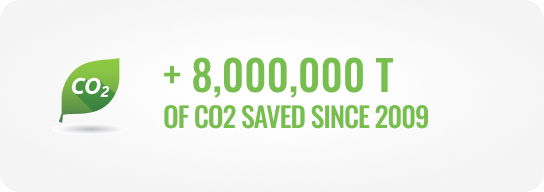

Refrigerators, freezers,
washing machines, cooking stoves
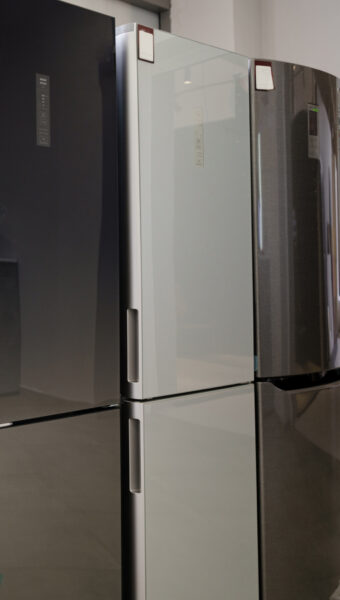
Some equipment contains substances that deplete the ozone layer, such as chlorofluorocarbons (CFCs) or hydrofluorocarbons (HFCs), which are now banned in the manufacture of a new product. That is why old equipment of this type is treated and recycled in a special facility.

A refrigerator is first decontaminated, i.e. the mineral oils and refrigerants are extracted, and after the components are disassembled, the remaining parts go into giant shredders to be shredded, separated by magnets or absorption. It results in recovered materials: ferrous and non-ferrous metals, polyurethane foam and glass, which are then used as secondary raw material by other industries. A lot of information, right? But did you know that 1/3 of the freon in a refrigerator is found in a gaseous state?
Why should we recycle them? Metals, plastics and dangerous substances can leach into groundwater and soil or evaporate and cause health problems and pollute the environment.
Refrigerators and freezers manufactured before 1995 often contain CFC refrigerants. They also have PCBs. ACs and dehumidifiers manufactured before 2010 contain HCFCs. Both affect the ozone layer.
![]() Just by recycling a refrigerator, GreenWEEE saves the CO2 equivalent of the emissions made by a car that circles the planet Earth twice.
Just by recycling a refrigerator, GreenWEEE saves the CO2 equivalent of the emissions made by a car that circles the planet Earth twice.

Vacuum cleaners, irons,
coffee filters, scales

Coffee filters, IT equipment, keyboards, toasters, vacuum cleaners or washing machines are transformed into fractions of plastic, ferrous and non-ferrous metals, glass, cables and integrated circuit boards, all in one plant.
As technology advances, these devices also have new designs. Some are bulkier or heavier, others are thinner, with different accessories. But this also means a lot of materials are used in their production, which sometimes makes the recycling process harder.
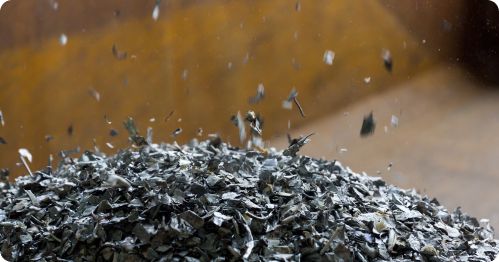
But thanks to our state of the art technology, we manage to recover up to 98% of the equipment. Nothing is lost, everything is recycled!

Plasma and LCD TVs

Plasma and LCD TVs make up a large part of today’s TV market, and many consumers are now buying their second or third flat screen TVs and recycling the first generation unit.
LCD and plasma TV units may contain beryllium, cadmium, lead, mercury and PCB, each of which may pose risks to human health. Careful and responsible dismantling is essential to ensure safety.

Non-functional TVs and monitors are manually disassembled by removing the li-ion battery (in the case of laptop screens), then transferred to an isolated room to recover the digital board, plastic support, aluminum or steel frame, screen, PET plastic and fluorescent tubes. All these materials are carefully separated. Nothing is lost, everything is recycled!

Economic bulbs, direct fluorescent lamps, HID

The lighting equipment that enters the production stream for recycling are the so-called economic bulbs: direct fluorescent lamps, high intensity discharge (HID) lamps, mercury vapor lamps, CFL lamps, but also electric arc lamps or incandescent light bulbs. All lighting equipment containing fluorescent mercury powder is recycled, resulting in small pieces of uncontaminated glass shards after this processing.
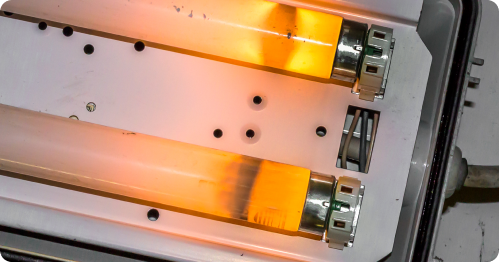
The mercury found in the fluorescent powder is in vapour form, but it should be noted that it is not exposed to the environment unless we accidentally break an economical light bulb, or when the lighting equipment is thrown into the household waste bin or dumpsters.
Recycling prevents the release of mercury into the atmosphere, so that it doesn’t make it in the environment.
Almost all components can be reused – by recycling we can reuse glass, ferrous and non-ferrous metals and other materials that make up lighting equipment. Normally, all components of a fluorescent light bulb can be recycled.
And that’s exactly what we do. We make sure that all the equipment that ends up being recycled is treated with maximum safety. The lighting equipment that enters the production stream for recycling are the so-called economic bulbs: direct fluorescent lamps, high intensity discharge (HID) lamps, mercury vapor lamps, CFL lamps, but also electric arc lamps or incandescent light bulbs.
![]() In 2022, we recycled over 10 million pieces of lighting equipment.
In 2022, we recycled over 10 million pieces of lighting equipment.

Routers, modems

IT&C equipment is complex and at the end of its life can be recycled. The most common devices are modems, routers, hubs, bridges or switches. All of this goes through GreenWEEE facilities to be shredded and turned into secondary raw material.
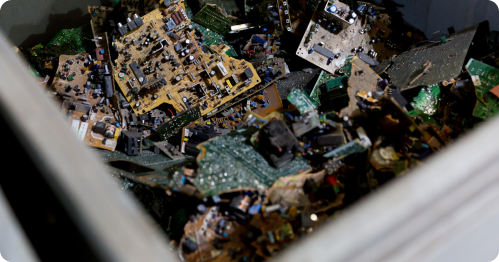
Every piece of equipment is different, but common materials from IT equipment recycling include non-ferrous metals, aluminum, copper, shredded plastics, and network cards.
![]() Toner cartridges, when removed intact from the housing, can be efficiently refilled and reused in the aftermarket.
Toner cartridges, when removed intact from the housing, can be efficiently refilled and reused in the aftermarket.


Large copiers and printers contain many recyclables such as iron, aluminum, plastics and glass. Motherboards can also be disassembled and recycled.
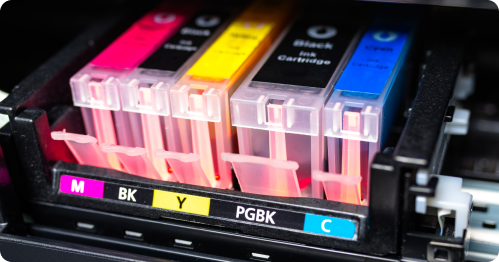
![]() Toner cartridges, when removed intact from the housing, can be efficiently refilled and reused on the aftermarket.
Toner cartridges, when removed intact from the housing, can be efficiently refilled and reused on the aftermarket.


How many of us still have CRT tube televisions or computer screens at home? Today we buy flat screen equipment, which means that millions of CRT tube monitors are still in our homes, ready to be sent to recycling.

Older CRT monitors must be carefully disassembled piece by piece to get to the CRT tube, which is made of leaded glass that can harm the environment and cause adverse effects to human health.
CRTs contain various materials such as plastic packaging/housing, power boards, cables, (copper), printed circuit boards, glass, speakers, copper coils, wood, and glass CRT tubes.
Cathode ray tubes (CRTs) from a television cannot be disposed of in a landfill. To protect our environment, we aim to eliminate every piece of dangerous WEEE, primarily by taking care of dangerous substances, both as a way of handling, storing and sending them for disposal. All the operations carried out are carefully recorded and monitored in order to have a transparency of the WEEE flow.


In case you think you’re carrying a gold mine in your pocket, you’re not. The amount of precious metals found in electronic devices, especially mobile phones, is substantial, just on a large scale. For example, from one million mobile phones you can get: 16 tons of copper, 350 kg of silver, 34 kg of gold and 14 kg of palladium. (according to the EPA). The challenge is to recover them efficiently and safely.
By recycling 1 MILLION mobile phones, we reduce greenhouse gasses equivalent to the same amount that 1,368 cars emit on the road in one year.
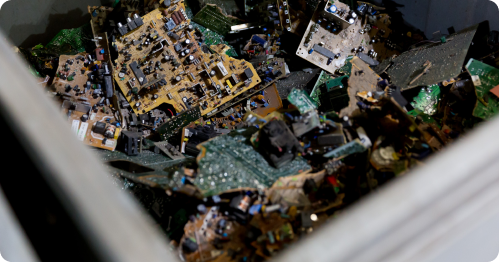
Mobile phones contain:
Precious and semi-precious metals such as gold, platinum and palladium, from which jewelry can be made. Zinc is used in shipbuilding, in zinc ingots, and to stop rust from forming.


Batteries – commonly found in portable electronic devices of electrical and electronic equipment, pre-installed as part of a device, as disposable or rechargeable power sources, can be a dangerous source of heat, sparks and fire if not properly prepared for storage and transportation.
Whether pre-installed as part of a device or disposable or rechargeable power sources, batteries must be handled with care and recycled properly.
Several types of batteries arrive at our locations, which we sort, handle and store with utmost care.
Primary batteries are batteries that can only be used once, not having the rechargeable function. This category includes battery types: carbonzinc, Li-MnO2, silver-zinc, zinc-MnO2, Zinc-Air, alkaline.
Secondary batteries are rechargeable batteries. This category includes battery types: Ni-Cd, Ni-MH, Li-ion, Pb-Acid.
Our facilities allow recycling of primary batteries. A first step in this process is sorting, which ensures the elimination of foreign bodies, so that the batteries then enter a mechanical sieve, where the pill-type ones are separated.
The mechanical treatment consists of several operations: the batteries are crushed in a grinder that can reduce the batteries into fragments from 0 to 15/20mm, then a magnetic separation takes place using a drum that extracts fragments of ferrous metals from the other materials. What results from the process is called “fractions”, which are actually secondary raw material for other industries: “black mass” (a mixture of carbon, zinc and manganese), iron and aluminum.


Nothing is wasted, everything is recycled, including electrical cables.
We have a line dedicated to their recycling in our factory. The first step is to sort them, with the aim of removing visible plastic materials and possible impurities. The cables then go into a shredder, where they are shredded and the ferrous metal parts are removed by magnetic separation.
What do we recover? Copper, aluminum and PVC or PE plastic. All these materials are reintroduced into the economic circuit, being considered secondary raw materials.

IT&C equipment is complex and at the end of its life can be recycled

IT&C equipment is complex and at the end of its life can be recycled. The most common devices are modems, routers, hubs, bridges or switches. All of this goes through GreenWEEE facilities to be shredded and turned into secondary raw material.
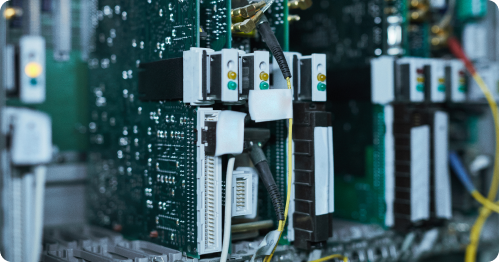
Every piece of equipment is different, but common materials from IT equipment recycling include non-ferrous metals, aluminum, copper, shredded plastics, and network cards.
![]() Toner cartridges, when removed intact from the housing, can be efficiently refilled and reused in the aftermarket.
Toner cartridges, when removed intact from the housing, can be efficiently refilled and reused in the aftermarket.

Granules, wire, pieces and parts of copper cables

Aluminum from cables, shredded aluminum from refrigerators and others

Shredded iron from refrigerators and various WEEE

Fractions of non-ferrous materials representing the base of the lamps

Circuit boards, radiators, electric motors and more

Plastic from various WEEE

Transparent, fraction size <150 mm

Transparent or opaque, fraction size <40 mm
